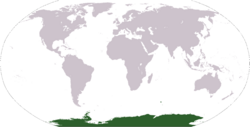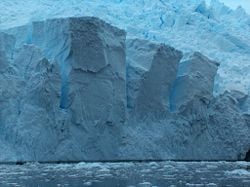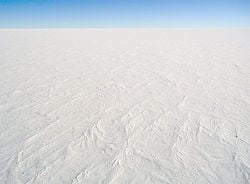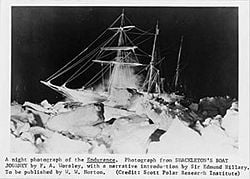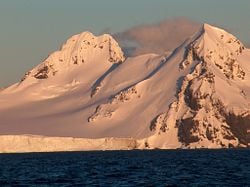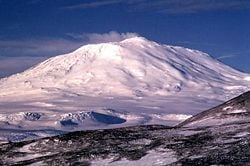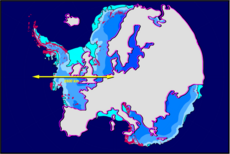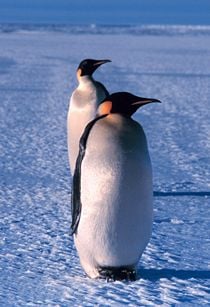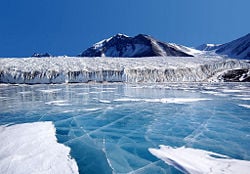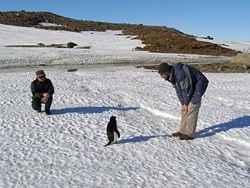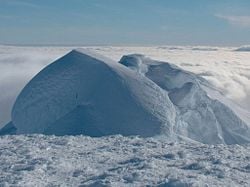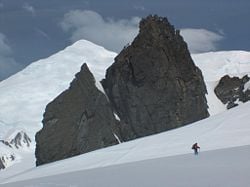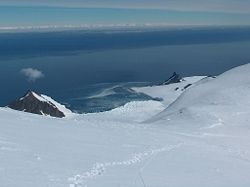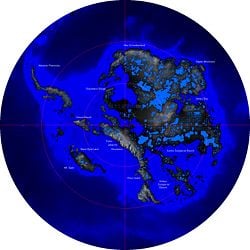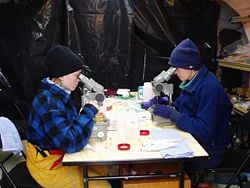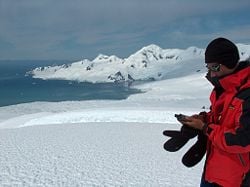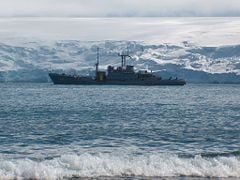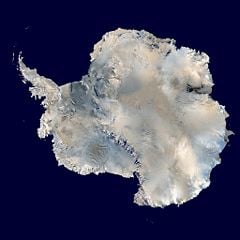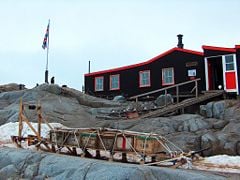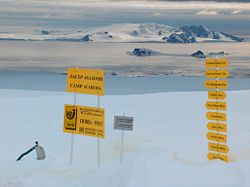Difference between revisions of "Antarctica" - New World Encyclopedia
Mary Anglin (talk | contribs) m (→Climate) |
Rosie Tanabe (talk | contribs) |
||
| (41 intermediate revisions by 10 users not shown) | |||
| Line 1: | Line 1: | ||
| − | {{ | + | {{Paid}}{{Approved}}{{Submitted}}{{Images OK}}{{copyedited}} |
| − | {| | + | {|class="infobox" width="175" style="float:right;"margin:0 0 1em 1em;" background: #f9f9f9; border: 1px #aaaaaa solid; border-collapse: collapse; font-size: 95%;" |
|+<big><big>'''Antarctica'''</big></big> | |+<big><big>'''Antarctica'''</big></big> | ||
| align=center colspan=2 style="background:#f9f9f9;" | | | align=center colspan=2 style="background:#f9f9f9;" | | ||
| Line 11: | Line 11: | ||
| '''[[Population]]''' || ~1000 (none permanent) | | '''[[Population]]''' || ~1000 (none permanent) | ||
|- | |- | ||
| − | | '''[[Government]]''' <br/><br/> | + | | '''[[Government]]''' <br/><br/>[[Executive Secretary]] |
|| governed by the [[Antarctic Treaty Secretariat]]<br/><br/>[[Johannes Huber]] | || governed by the [[Antarctic Treaty Secretariat]]<br/><br/>[[Johannes Huber]] | ||
|- | |- | ||
| Line 23: | Line 23: | ||
|} | |} | ||
| − | |||
| − | '''Antarctica''' is [[Earth]]'s southernmost | + | '''Antarctica''' is [[Earth]]'s southernmost continent, overlying the [[South Pole]]. Situated in the [[southern hemisphere]] and largely south of the [[Antarctic Circle]], Antarctica is surrounded by the [[Southern Ocean]]. At 14.4 million km², it is the fifth-largest continent in area after [[Asia]], [[Africa]], [[North America]], and [[South America]]; in turn, [[Europe]] and [[Australia]] are smaller. Some 98 percent of Antarctica is covered by ice, which averages at least 1.6 km in thickness. |
| − | On average, Antarctica is the coldest, driest and windiest continent, and has the highest average | + | On average, Antarctica is the coldest, driest, and windiest continent, and has the highest average elevation of all the continents.<ref>National Geophysical Data Center, [http://www.ngdc.noaa.gov/mgg/image/2minrelief.html NOAA Satellite and Information Services.] Retrieved July 20, 2017. </ref> Since there is little precipitation, except at the coasts, the interior of the continent is technically the largest [[desert]] in the world. There are no permanent human residents and Antarctica has never had an indigenous population. Only cold-adapted plants and animals survive there, including [[penguin]]s, [[fur seal]]s, [[moss]]es, [[lichen]]s, and many types of [[algae]]. |
| − | The name ''Antarctica'' comes from the [[Greek language|Greek]] ''antarktikos'' | + | The name ''Antarctica'' comes from the [[Greek language|Greek]] ''antarktikos'', meaning "opposite to the [[Arctic]]." Although myths and speculation about a ''Terra Australis'' ("Southern Land") date back to antiquity, the first confirmed sighting of the continent is commonly accepted to have occurred in 1820 by the [[Russia]]n expedition of Mikhail Lazarev and Fabian Gottlieb von Bellingshausen. However, the continent remained largely neglected for the rest of the nineteenth century because of its hostile environment, lack of resources, and isolated location. |
| + | {{toc}} | ||
| + | The Antarctic Treaty was signed in 1959 by twelve countries. To date, forty-five countries have signed the treaty. The treaty prohibits military activities and mineral mining, supports scientific research, and protects the continent's [[ecozone]]. Ongoing experiments are conducted by more than 4,000 scientists of many nationalities and with different research interests. | ||
| − | + | ==History== | |
| + | [[Image:Austral-Ice.jpg|250px|thumb|right|Antarctic Peninsula glacier.]] | ||
| + | [[Image:AntarcticaDomeCSnow.jpg|250px|thumb|right|The snow surface at Dome C Station is representative of the majority of the continent's surface.]] | ||
| + | Belief in the existence of a ''Terra Australis''—a vast continent located in the far south of the globe to "balance" the northern lands of [[Europe]], [[Asia]], and North [[Africa]]—had existed since the times of [[Ptolemy]] (first century CE), who suggested the idea in order to preserve the [[symmetry]] of all known landmasses in the world. Depictions of a large southern landmass were common in maps such as the early sixteenth century Turkish Piri Reis map. Even in the late seventeenth century, after explorers had found that [[South America]] and [[Australia]] were not part of the fabled "Antarctica," geographers believed that the continent was much larger than its actual size. | ||
| + | |||
| + | European maps continued to show this hypothetical land until Captain [[James Cook]]'s ships, HMS ''Resolution'' and ''Adventure'', crossed the [[Antarctic Circle]] on January 17, 1773, and once again in 1774.<ref>The Mariner's Museum, [http://www.mariner.org/educationalad/ageofex/cook.php Age of Exploration.] Retrieved July 20, 2017.</ref> The first confirmed sightings of Antarctica took place in 1920 and is credited to captains and crews of three ships: | ||
| + | |||
| + | *Fabian Gottlieb von Bellingshausen (a captain in the Russian Imperial Navy), | ||
| + | *Edward Bransfield (a captain in the British Navy), and | ||
| + | *Nathaniel Palmer (an American sealer out of Stonington, Connecticut). | ||
| − | + | Von Bellingshausen is reported to have sighted Antarctica on January 27, 1820, three days before Bransfield sighted land, and ten months before Palmer did so in November 1820. On that day the two-ship expedition led by Von Bellingshausen and Mikhail Petrovich Lazarev reached a point within 32 km (20 miles) of the Antarctic mainland and saw ice fields there. The first documented landing on mainland Antarctica was by the American sealer John Davis in Western Antarctica on February 7, 1821, although some historians dispute this claim. | |
| − | + | ||
| − | + | In December 1839, as part of the United States Exploring Expedition of 1838–1842 (conducted by the United States Navy), the expedition comprised of 433 men and six ships sailed from Sydney, [[Australia]] into the Antarctic Ocean, as it was then known, and reported the discovery "of an Antarctic continent west of the Balleny Islands." That part of Antarctica was later named "Wilkes Land," after the expedition's commander, Lt. [[Charles Wilkes]], a name it maintains to this day. | |
| − | + | ||
| − | + | In 1841, explorer [[James Ross|James Clark Ross]] passed through what is now known as the Ross Sea and discovered Ross Island (both of which were named for him). He sailed along a huge wall of ice that was later named the Ross Ice Shelf. Mount Erebus and Mount Terror are named after two ships from his expedition: HMS ''Erebus'' and ''Terror''.<ref>SouthPole.com, [http://www.south-pole.com/p0000081.htm James Clark Ross.] Retrieved July 20, 2017.</ref> Mercator Cooper landed in Eastern Antarctica on January 26, 1853. | |
| − | In December 1839, as part of the | + | [[Image:Shackleton_expedition.jpg|right|thumb|250px|''The Endurance'' at night during [[Ernest Shackleton]]'s Imperial Trans-Antarctic Expedition in 1914.]] |
| − | + | During an expedition led by [[Ernest Shackleton]] in 1907, parties led by T. W. Edgeworth David became the first to climb Mount Erebus and to reach the [[South Magnetic Pole]]. <ref>Australian Antarctic Division, [http://www.antarctica.gov.au/about-antarctica/history/people/tannatt-edgeworth-david Tannatt William Edgeworth David.] Retrieved July 20, 2017.</ref> In addition, Shackleton himself and three other members of his expedition made several firsts in December 1908–February 1909: they were the first humans to traverse the Ross Ice Shelf, the first to traverse the Transantarctic Mountain Range (via the Beardmore Glacier), and the first to set foot on the South Polar Plateau. | |
| − | |||
| − | During an | ||
| − | [[ | + | On December 14, 1911, a party led by Norwegian polar explorer [[Roald Amundsen]] from the ship ''Fram'' became the first to reach the geographic [[South Pole]], using a route from the Bay of Whales and up the Axel Heiberg Glacier.<ref>SouthPole.com, [http://www.south-pole.com/p0000101.htm Roald Amundsen.] Retrieved July 20, 2017.</ref> One month later, the Scott Expedition reached the pole. |
| − | + | Richard Evelyn Byrd led several voyages to the Antarctic by plane in the 1930s and 1940s. He is credited with implementing mechanized land transport on the continent and conducting extensive geological and biological research. However, it was not until October 31, 1956, that anyone set foot on the South Pole again; on that day a U.S. Navy group led by Rear Admiral [[George Dufek]] successfully landed an aircraft there. | |
| − | |||
==Geography== | ==Geography== | ||
| − | [[Image:Antarctica | + | [[Image:Maritime-Antarctica.jpg|thumb|250px|right|Maritime Antarctica.]] |
| − | [[Image: | + | [[Image:Mt_erebus.jpg|thumb|right|250px|Mount Erebus, an active volcano on Ross Island.]] |
| − | |||
| − | |||
| − | Antarctica is | + | Centered asymmetrically around the South Pole and largely south of the Antarctic Circle, Antarctica is the southernmost continent and is surrounded by the southern waters of the [[World Ocean]]. Alternatively it is washed by the [[Southern Ocean]] or the southern [[Pacific Ocean|Pacific]], [[Atlantic Ocean|Atlantic]], and [[Indian Ocean]]s. It covers more than 14 million km², making it the fifth-largest continent, about 1.3 times larger than [[Europe]]. The coastline measures 17,968 km (11,160 miles) and is mostly characterized by [[ice]] formations. |
| − | + | Antarctica is divided in two by the Transantarctic Mountains close to the neck between the Ross Sea and the Weddell Sea. The portion west of the Weddell Sea and east of the Ross Sea is called Western Antarctica and the remainder Eastern Antarctica, because they roughly correspond to the Western and Eastern Hemispheres relative to the [[Greenwich meridian]]. | |
| − | + | Approximately 98 percent of Antarctica is covered by the [[Antarctic ice sheet]], a sheet of ice averaging at least one mile in thickness. The continent has approximately 90 percent of the world's ice (and thereby approximately 70 percent of the world's fresh water). If all of this ice were melted, sea levels would rise about 200 feet (61 m). In most of the interior of the continent precipitation is very low, down to 20 mm/year; in a few "blue ice" (glacial ice) areas precipitation is lower than mass loss by sublimation causing the local mass balance to be negative. In the dry valleys the same effect occurs over a rock base, leading to a desiccated landscape. | |
| − | [[Image: | + | Western Antarctica is covered by the West Antarctic Ice Sheet. The sheet has been of recent concern because of the real, if small, possibility of its collapse. If the sheet were to break down, ocean levels would rise by several meters in a relatively geologically short period of time, perhaps a matter of centuries. Several Antarctic ice streams, which account for about 10 percent of the ice sheet, flow to one of the many Antarctic ice shelves. |
| − | + | [[Image:Europe_antarctica_size.png|thumb|left|230px|Size comparison Europe-Antarctica.]] | |
| + | Vinson Massif, the highest peak in Antarctica at 16,050 feet (4,892 meters), is located in the Ellsworth Mountains. Although Antarctica is home to many volcanoes, only Mount Erebus is known to be active. Located on Ross Island, Erebus is the southernmost active volcano. There is another famous volcano called Deception Island, which is famous for its giant eruption in 1970. Minor eruptions are frequent and lava flow has been observed in recent years. Other dormant volcanoes may potentially be active. In 2004, an underwater volcano was found in the Antarctic Peninsula by American and Canadian researchers. Recent evidence shows this unnamed volcano may be active.<ref>National Science Foundation, [http://www.nsf.gov/news/news_summ.jsp?cntn_id=100385 Scientists Discover Undersea Volcano Off Antarctica.] Retrieved July 20, 2017.</ref> | ||
| − | Antarctica is home to more than 70 [[lake]]s that lie thousands of meters under the surface of the continental ice sheet. | + | Antarctica is home to more than 70 [[lake]]s that lie thousands of meters under the surface of the continental ice sheet. Lake Vostok, discovered beneath [[Russia]]'s Vostok Station in 1996, is the largest of these subglacial lakes similar in size to [[Lake Ontario]]. It is believed that the lake has been sealed off for 25 million years. There is some evidence, in the form of ice cores drilled to about 400 m above the water line, that Vostok's waters may contain [[microorganism|microbial life]]. The sealed, frozen surface of the lake shares similarities with [[Jupiter]]'s moon Europa. If life is discovered in Lake Vostok, this would strengthen the argument for the possibility of life on Europa. |
=== Flora and fauna === | === Flora and fauna === | ||
| + | [[Image:Lichen_squamulose.jpg|thumb|225px|right|More than 200 species of [[lichen]]s are known in Antarctica.]] | ||
==== Flora ==== | ==== Flora ==== | ||
| − | + | The climate of Antarctica does not allow extensive vegetation. A combination of freezing temperatures, poor soil quality, lack of moisture, and lack of sunlight inhibit the flourishing of plants. As a result, plant life is limited to mostly [[moss]]es and [[Marchantiophyta|liverwort]]s. The autotrophic community is made up of mostly [[protist]]s. The flora of the continent largely consists of [[lichen]]s, [[bryophyte]]s, [[algae]], and [[fungi]]. Growth generally occurs in the summer, and only for a few weeks at most. | |
| − | |||
| − | The climate of Antarctica does not allow extensive vegetation. A combination of freezing temperatures, poor | ||
| − | There are more than 200 species of lichens and approximately 50 species of bryophytes, such as mosses. Seven hundred species of algae exist, most of which are [[phytoplankton]]. Multicolored | + | There are more than 200 species of lichens and approximately 50 species of bryophytes, such as mosses. Seven hundred species of algae exist, most of which are [[phytoplankton]]. Multicolored snow algae and [[diatoms]] are especially abundant in the coastal regions during the summer. There are two species of flowering plants found in the Antarctic Peninsula: ''Deschampsia antarctica'' (Antarctic hair grass) and ''Colobanthus quitensis'' (Antarctic pearlwort). |
==== Fauna ==== | ==== Fauna ==== | ||
| − | + | [[Image:Emperor_penguin.jpg|thumb|210px|left|Emperor Penguins in Ross Sea, Antarctica.]] | |
| − | + | Land fauna is nearly completely [[invertebrate]]. Invertebrate life includes [[microscopic]] [[mite]]s, [[lice]], [[Roundworm|nematode]]s, [[tardigrades]], [[rotifers]], [[krill]], and [[springtail]]s. The flightless midge ''Belgica antarctica,'' just 12 mm in size, is the largest land animal in Antarctica. The Snow Petrel is one of only three birds that breed exclusively in Antarctica. They have been seen at the South Pole. | |
| − | |||
| − | A variety of marine animals exist and rely, directly or indirectly, on the phytoplankton. Antarctic sea life includes [[penguin]]s, [[blue | + | A variety of marine animals exist and rely, directly or indirectly, on the phytoplankton. Antarctic sea life includes [[penguin]]s, [[blue whale]]s, [[orca]]s, and [[fur seal]]s. The Emperor penguin is the only penguin that breeds during the winter in Antarctica, while the Adélie Penguin breeds farther south than any other penguin. The Rockhopper penguin has distinctive feathers around the eyes, giving the appearance of elaborate eyelashes. King penguins, Chinstrap penguins, and Gentoo Penguins also breed in the Antarctic. It is the male partner of both the King and Emperor penguins that is responsible for incubating the single egg for up to two months by balancing it on top of their feet and keeping it warm under a special pouch, while the female feeds out at sea. |
| − | The | + | The Antarctic fur seal was very heavily hunted in the eighteenth and nineteenth centuries for its pelt by sealers from the [[United States]] and the [[United Kingdom]]. The Weddell Seal, a "true seal," is named after Sir James Weddell, commander of British sealing expeditions in the Weddell Sea. Antarctic krill, which congregates in large schools, is the keystone species of the [[ecosystem]] of the Southern Ocean, and is an important food organism for whales, seals, leopard seals, fur seals, [[squid]], [[icefish]], penguins, [[albatross]]es, and many other birds. |
| − | The | + | The 1978 enactment of the [[Antarctic Conservation Act]] in the U.S. brought several restrictions to U.S. activity on the continent. The introduction of alien plants or animals can bring a criminal penalty, as can the extraction of any indigenous species. The overfishing of krill, which plays a large role in the Antarctic ecosystem, led officials to enact regulations on [[fishing]]. The Convention for the Conservation of Antarctic Marine Living Resources (CCAMLR), a treaty that came into force in 1980, requires that regulations managing all Southern Ocean fisheries consider potential effects on the entire Antarctic [[ecosystem]]. Despite these new acts, unregulated and illegal fishing, particularly of Patagonian toothfish, remains a serious problem. The illegal fishing of toothfish has been increasing, with estimates of 32,000 tons in the year 2000. |
=== Climate === | === Climate === | ||
| + | [[Image:Fryxellsee Opt.jpg|thumb|left|250px|The blue ice covering Lake Fryxell, in the Transantarctic Mountains, comes from glacial meltwater from the Canada Glacier and other smaller glaciers.]] | ||
| + | [[Image:AntarcticaSummer.jpg|right|thumb|250px| Near the coast, December looks fairly temperate.]] | ||
| + | [[Image:Friesland-St-Boris.jpg|250px|thumb|right|Mountain glaciation.]] | ||
| + | Antarctica is the coldest place on [[Earth]]. It is a frozen desert with little precipitation; the South Pole itself receives less than 4 inches (10 cm) per year, on average. [[Temperature]]s reach a minimum of between -80°C and -90°C (-112°F and -130°F) in the interior in winter and reach a maximum of between 5°C and 15°C (41°F and 59°F) near the coast in summer. Sunburn is often a health issue as the snow surface reflects almost all of the ultraviolet light falling on it. | ||
| − | + | Eastern Antarctica is colder than its western counterpart because of its higher elevation. Weather fronts rarely penetrate far into the continent, leaving the center cold and dry. Despite the lack of precipitation over the central portion of the continent, ice there lasts for extended time periods. Heavy snowfalls are not uncommon on the coastal portion of the continent, where snowfalls of up to 1.22 meters (48 inches) in 48 hours have been recorded. At the edge of the continent, strong katabatic winds off the polar plateau often blow at storm force. In the interior, however, wind speeds are typically moderate. During summer, more solar radiation reaches the surface during clear days at the South Pole than at the equator because of the 24 hours of sunlight each day at the Pole. | |
| − | |||
| − | |||
| − | |||
| − | |||
| − | + | Antarctica is colder than the [[Arctic]] for two reasons. First, much of the continent is more than 3 km above sea level, and temperature decreases with elevation. Second, the [[Arctic Ocean]] covers the north polar zone: The ocean's relative warmth is transferred through the icepack and prevents temperatures in the Arctic regions from reaching the extremes typical of the land surface of Antarctica. | |
| − | + | Given the latitude, long periods of constant darkness or constant sunlight create climates unfamiliar to human beings in much of the rest of the world. The [[aurora australis]], commonly known as the southern lights, is observed in the night sky near the South Pole. Typically the aurora appears either as a diffused glow or as "curtains" that approximately extend in the east-west direction. Each curtain consists of many parallel rays, each lined up with the local direction of the magnetic field lines, suggesting that aurora is shaped by the [[earth's magnetic field]]. Another unique spectacle is diamond dust, a ground-level cloud composed of tiny ice crystals that may continue for several days without interruption. It generally forms under otherwise clear or nearly clear skies, so people sometimes also refer to it as clear-sky precipitation. A sun dog, a frequent atmospheric optical phenomenon, is a bright "spot" beside the true sun that typically appears when the sun is low, such as at sunrise and sunset. | |
=== Geology === | === Geology === | ||
| + | [[Image:Survey-Route.jpg|250px|thumb|right|Survey route.]] | ||
| + | [[Image:Bransfield-Strait.jpg|250px|thumb|right|Bransfield Strait.]] | ||
| + | ==== Geological history and paleontology ==== | ||
| + | More than 170 million years ago, Antarctica was part of the supercontinent [[Gondwana]]. Over time, Gondwana gradually broke apart and Antarctica as it is known today was formed around 25 million years ago. | ||
| − | |||
| − | |||
===== Paleozoic era (540-250 Mya) ===== | ===== Paleozoic era (540-250 Mya) ===== | ||
| − | [[ | + | During the [[Cambrian]] period, Gondwana had a mild climate. West Antarctica was partially in the northern hemisphere, and during this period large amounts of [[sandstone]]s, [[limestone]]s, and [[shale]]s were deposited. East Antarctica was at the equator, where sea-floor [[invertebrate]]s and [[trilobite]]s flourished in the tropical seas. By the start of the [[Devonian]] period (416 Mya), Gondwana was in more southern latitudes and the climate was cooler, though fossils of land plants are known from this time. [[Sand]] and [[silt]]s were laid down in what is now the Ellsworth, Horlick, and Pensacola Mountains. [[Glaciation]] began at the end of the Devonian period (360 Mya), as Gondwana became centered around the [[South Pole]] and the climate cooled, though flora remained. During the Permian period, the plant life became dominated by [[fern]]-like plants such as ''Glossopteris'', which grew in swamps. Over time these swamps became deposits of coal in the Transantarctic Mountains. Towards the end of the [[Permian]] period, continued warming led to a dry, hot climate over much of Gondwana. |
| − | |||
===== Mesozoic era (250-65 Mya) ===== | ===== Mesozoic era (250-65 Mya) ===== | ||
| − | + | ||
| − | As a result of continued warming, the polar ice caps melted and much of Gondwana became a desert. In East Antarctica, the | + | As a result of continued warming, the polar ice caps melted and much of Gondwana became a [[desert]]. In East Antarctica, the seed fern became established, and large amounts of sandstone and shale were laid down at this time. The Antarctic Peninsula began to form during the [[Jurassic]] period (206-146 Mya), and islands gradually rose out of the ocean. [[Ginkgo]] trees and [[cycad]]s were plentiful during this period, as were reptiles such as ''[[Lystrosaurus]].'' In West Antarctica, [[conifer]]ous [[forest]]s dominated through the entire [[Cretaceous]] period (146-65 Mya), though [[Nothofagus|Southern beech]] began to take over at the end of this period. [[Ammonite]]s were common in the seas around Antarctica, and [[dinosaur]]s were also present, though only two Antarctic dinosaur species (''[[Cryolophosaurus]],'' from the [[Mount Kirkpatrick Formation|Hanson Formation]], and ''[[Antarctopelta]]'') have been described to date. It was during this period that Gondwana began to break up. |
===== Gondwana breakup (160-23 Mya) ===== | ===== Gondwana breakup (160-23 Mya) ===== | ||
| − | [[Africa]] separated from Antarctica around 160 Mya, followed by the [[Indian subcontinent]], in the early Cretaceous (about 125 Mya). About 65 Mya, Antarctica (then connected to [[Australia]]) still had a tropical to subtropical climate, complete with a [[marsupial]] fauna. About 40 Mya | + | [[Africa]] separated from Antarctica around 160 Mya, followed by the [[India|Indian subcontinent]], in the early Cretaceous (about 125 Mya). About 65 Mya, Antarctica (then connected to [[Australia]]) still had a tropical to subtropical climate, complete with a [[marsupial]] fauna. About 40 Mya Australia-[[New Guinea]] separated from Antarctica and the first ice began to appear. Around 23 Mya, the [[Drake Passage]] opened between Antarctica and [[South America]], which resulted in the [[Antarctic Circumpolar Current]]. The ice spread, replacing the [[forest]]s that then covered the continent. Since about 15 Mya, the continent has been mostly covered with ice. |
==== Geology of present-day Antarctica ==== | ==== Geology of present-day Antarctica ==== | ||
| − | [[Image:AntarcticaRockSurface.jpg|thumb| | + | [[Image:AntarcticaRockSurface.jpg|thumb|250px|Antarctica without its ice-shield. This map does not consider that sea level would rise because of the melted ice, nor that the landmass would rise by several hundred meters over a few tens of thousands of years after the weight of the ice was no longer depressing the landmass.]] |
| − | |||
| − | |||
| − | + | The geological study of Antarctica has been greatly hindered by the fact that nearly all of the continent is permanently covered with a thick layer of ice. However, new techniques such as remote sensing, ground-penetrating radar, and satellite imagery have begun to reveal the structures beneath the ice. | |
| − | + | Geologically, West Antarctica closely resembles the [[Andes]] mountain range of [[South America]]. The [[Antarctic Peninsula]] was formed by uplift and metamorphism of sea-bed sediments during the late Paleozoic and the early Mesozoic eras. This sediment uplift was accompanied by [[igneous]] intrusions and volcanism. The most common rocks in West Antarctica are [[andesite]] and [[rhyolite]] volcanics formed during the Jurassic period. There is also evidence of volcanic activity, even after the ice sheet had formed, in Marie Byrd Land and Alexander Island. The only anomalous area of West Antarctica is the Ellsworth Mountains region, where the stratigraphy is more similar to the eastern part of the continent. | |
| − | The main [[mineral]] resource known on the continent is [[coal]]. | + | East Antarctica is geologically varied, dating from the [[Precambrian]] era, with some rocks formed more than 3 billion years ago. It is composed of a [[metamorphic]] and [[igneous]] platform which is the basis of the [[continental shield]]. On top of this base are various modern rocks, such as [[sandstone]]s, [[limestone]]s, coal, and [[shale]]s laid down during the Devonian and Jurassic periods to form the Transantarctic Mountains. In coastal areas such as Shackleton Range and Victoria Land some faulting has occurred. |
| + | |||
| + | The main [[mineral]] resource known on the continent is [[coal]]. It was first recorded near the Beardmore Glacier by Frank Wild on the Nimrod Expedition, and now low-grade coal is known across many parts of the Transantarctic Mountains. The Prince Charles Mountains contain significant deposits of [[iron ore]]. The most valuable resources of Antarctica lie offshore, namely the [[oil]] and [[natural gas]] fields found in the [[Ross Sea]] in 1973. Exploitation of all mineral resources is banned until 2048 by the [[Protocol on Environmental Protection to the Antarctic Treaty]]. | ||
==Population== | ==Population== | ||
| − | Antarctica has no permanent residents, but a number of governments maintain permanent | + | [[Image:Antarctic_researchers.jpg|thumb|right|250px|Two researchers studying plankton through microscopes.]] |
| − | + | [[Image:Fieldwork-Melnik.jpg|250px|thumb|right|Field work.]] | |
| − | + | Antarctica has no permanent residents, but a number of governments maintain permanent research stations throughout the continent. The number of people conducting and supporting scientific research and other work on the continent and its nearby islands varies from approximately 4,000 in summer to about 1,000 in winter. Many of the stations are staffed year-round. | |
| − | |||
| − | |||
| − | |||
| − | + | The first semi-permanent inhabitants of regions near Antarctica (areas situated south of the Antarctic Convergence) were [[Great Britain|British]] and [[United States|American]] sealers who often spent a year or more on South Georgia Island, beginning in 1786. During the whaling era, which lasted until 1966, the population of that island varied from over 1,000 in the summer (over 2,000 in some years) to some 200 in the winter. Most of the whalers were [[Norway|Norwegian]], with an increasing proportion of Britons. The settlements included Grytviken, Leith Harbour, King Edward Point, Stomness, Husvik, Prince Olav Harbour, Ocean Harbour, and Godthul. Managers and other senior officers of the whaling stations often lived together with their families. Among them was the founder of Grytviken, Captain [[Carl Anton Larsen]], a prominent Norwegian whaler and explorer who adopted British citizenship in 1910, along with his family. | |
| + | The first child born in the southern polar region was Norwegian girl Solveig Gunbjörg Jacobsen, born in Grytviken on October 8, 1913, with her birth being registered by the resident British Magistrate of South Georgia. She was a daughter of Fridthjof Jacobsen, the assistant manager of the whaling station, and of Klara Olette Jacobsen. Jacobsen arrived on the island in 1904 to become the manager of Grytviken, serving from 1914 to 1921; two of his children were born on the island. | ||
| + | Emilio Marcos Palma was the first person born on the Antarctic mainland, at Base Esperanza in 1978; his parents were sent there along with seven other families by the [[Argentina|Argentinean]] government to determine if family life was suitable on the continent. In 1986, Juan Pablo Camacho was born at the Presidente Eduardo Frei Montalva Base, becoming the first Chilean born in Antarctica. Several bases are now home to families with children attending schools at the station. | ||
| + | {{readout||right|250px|Antarctica has no indigenous population, no [[government]] and belongs to no country}} | ||
==Politics== | ==Politics== | ||
| + | As the only uninhabited continent, Antarctica has no government and belongs to no country. Various countries claim areas of it, although as a rule, no other countries recognize such claims. The area between 90°W and 150°W is the only part of Antarctica, indeed the only solid land on Earth, not claimed by any country. | ||
| + | [[Image:Logistic-Support.jpg|240px|thumb|right|Resupply by the Uruguayan Navy vessel 'Vanguardia'.]] | ||
| + | Since 1959, claims on Antarctica have been suspended and the continent is considered politically neutral. Its status is regulated by the 1959 [[Antarctic Treaty]] and other related agreements, collectively called the [[Antarctic Treaty System]]. For the purposes of the Treaty System, Antarctica is defined as all land and ice shelves south of 60°S. The treaty was signed by twelve countries, including the [[Soviet Union]] (and later [[Russia]]), the [[United Kingdom]], and the [[United States]]. It set aside Antarctica as a scientific preserve, established freedom of scientific investigation, environmental protection, and banned military activity on that continent. This was the first arms control agreement established during the [[Cold War]]. | ||
| − | + | The Antarctic Treaty prohibits any military activity in Antarctica, such as the establishment of military bases and fortifications, the carrying out of military maneuvers, or the testing of any type of weapon. Military personnel or equipment are permitted only for scientific research or for other peaceful purposes.<ref>Scientific Committee on Antarctic Research, [http://www.scar.org/treaty/ The Antarctic Treaty System: An Introduction.] Retrieved July 20, 2017. </ref> | |
| − | |||
| − | |||
| − | |||
| − | |||
| − | The Antarctic Treaty prohibits any | ||
| − | The | + | The United States military issues the Antarctica Service Medal to military members or civilians who perform research duty in Antarctica. The medal includes a "wintered over" bar issued to those who remain on the continent for two complete six-month seasons. |
| − | ===Antarctic | + | === The Antarctic Treaty === |
| − | [[Image: | + | [[Image:Antarctica 6400px from Blue Marble.jpg|thumb|240px|right|A satellite composite image of Antarctica.]] |
| − | + | [[Image:Port-Lockroy.jpg|240px|thumb|right|Port Lockroy Museum.]] | |
| − | + | The main treaty was opened for signature on December 1, 1959, and officially entered into force on June 23, 1961. The original signatories were the 12 countries active in Antarctica during the International Geophysical Year of 1957-58 and willing to accept a U.S. invitation to the conference at which the treaty was negotiated. These countries were [[Argentina]], [[Australia]], [[Belgium]], [[Chile]], [[France]], [[Japan]], [[New Zealand]], [[Norway]], [[South Africa]], the [[USSR]], the [[United Kingdom]], and the [[United States]] (which opened the Amundsen-Scott South Pole Station for the International Geophysical Year). | |
| − | |||
| − | The main treaty was opened for signature on December 1, 1959, and officially entered into force on June 23, 1961. The original signatories were the 12 countries active in Antarctica during the | ||
===== Articles of the Antarctic Treaty ===== | ===== Articles of the Antarctic Treaty ===== | ||
| − | *'''Article 1''' - area to be used for peaceful purposes only; military activity, such as weapons testing, is prohibited, but military personnel and equipment may be used for scientific research or any other peaceful purpose; | + | *'''Article 1'''--area to be used for peaceful purposes only; military activity, such as weapons testing, is prohibited, but military personnel and equipment may be used for scientific research or any other peaceful purpose; |
| − | *'''Article 2''' - freedom of scientific investigation and cooperation shall continue; | + | *'''Article 2'''--freedom of scientific investigation and cooperation shall continue; |
| − | *'''Article 3''' - free exchange of information and personnel in cooperation with the [[United Nations]] and other international agencies; | + | *'''Article 3'''--free exchange of information and personnel in cooperation with the [[United Nations]] and other international agencies; |
| − | *'''Article 4''' - does not recognize, dispute, or establish territorial claims and no new claims shall be asserted while the treaty is in force; | + | *'''Article 4'''--does not recognize, dispute, or establish territorial claims and no new claims shall be asserted while the treaty is in force; |
| − | *'''Article 5''' - prohibits nuclear explosions or disposal of radioactive wastes; | + | *'''Article 5'''--prohibits nuclear explosions or disposal of radioactive wastes; |
| − | *'''Article 6''' - includes under the treaty all land and ice shelves south of 60 degrees 00 minutes south; | + | *'''Article 6'''--includes under the treaty all land and ice shelves south of 60 degrees 00 minutes south; |
| − | *'''Article 7''' - treaty-state observers have free access, including aerial observation, to any area and may inspect all stations, installations, and equipment; advance notice of all activities and of the introduction of military personnel must be given; | + | *'''Article 7'''--treaty-state observers have free access, including aerial observation, to any area and may inspect all stations, installations, and equipment; advance notice of all activities and of the introduction of military personnel must be given; |
| − | *'''Article 8''' - allows for jurisdiction over observers and scientists by their own states; | + | *'''Article 8'''--allows for jurisdiction over observers and scientists by their own states; |
| − | *'''Article 9''' - frequent consultative meetings take place among member nations; | + | *'''Article 9'''--frequent consultative meetings take place among member nations; |
| − | *'''Article 10''' - treaty states will discourage activities by any country in Antarctica that are contrary to the treaty; | + | *'''Article 10'''--treaty states will discourage activities by any country in Antarctica that are contrary to the treaty; |
| − | *'''Article 11''' - disputes to be settled peacefully by the parties concerned or, ultimately, by the | + | *'''Article 11'''--disputes to be settled peacefully by the parties concerned or, ultimately, by the International Court of Justice; |
| − | *'''Articles 12, 13, 14''' - deal with upholding, interpreting, and amending the treaty among involved nations. | + | *'''Articles 12, 13, 14'''--deal with upholding, interpreting, and amending the treaty among involved nations. |
| − | The main objective of the ATS is to ensure | + | The main objective of the ATS is to ensure in the interests of all humanity that Antarctica shall continue forever to be used exclusively for peaceful purposes and shall not become the scene or object of international discord. The treaty forbids any measures of a military nature, but not the presence of military personnel per se. It avoided addressing the question of existing territorial claims asserted by some nations and not recognized by others. |
===Other agreements=== | ===Other agreements=== | ||
| − | + | Other agreements, some 200 recommendations adopted at treaty consultative meetings and ratified by governments, include: | |
| − | Other agreements | + | |
| − | * | + | *Agreed Measures for the Conservation of Antarctic Fauna and Flora (1964) (entered into force in 1982) |
| − | *The | + | *The Convention for the Conservation of Antarctic Seals (1972) |
| − | *The | + | *The Convention for the Conservation of Antarctic Marine Living Resources (1980) |
| − | *The | + | *The Convention on the Regulation of Antarctic Mineral Resource Activities (1988) (although it was signed in 1988, it was subsequently rejected and never entered into force) |
| − | *The | + | *The Protocol on Environmental Protection to the Antarctic Treaty was signed October 4, 1991 and entered into force January 14, 1998; this agreement prevents development and provides for the protection of the Antarctic environment through five specific annexes on marine pollution, fauna, and flora, environmental impact assessments, waste management, and protected areas. It prohibits all activities relating to mineral resources except scientific. |
==Economy== | ==Economy== | ||
| + | Although [[coal]], [[hydrocarbon]]s, [[iron ore]], [[platinum]], [[copper]], [[chromium]], [[nickel]], [[gold]], and other [[mineral]]s have been found, they have not been located in large enough quantities to exploit. The 1991 Protocol on Environmental Protection to the Antarctic Treaty also restricts a struggle for resources. In 1998, a compromise agreement was reached to add a 50-year ban on mining until the year 2048, further limiting economic development and exploitation. The primary agricultural activity is the capture and offshore trading of fish. Antarctic fisheries in 2000-01 reported landing 112,934 tons. | ||
| − | [[ | + | Small-scale [[tourism]] has existed since 1957 and is currently largely self-regulated by the International Association of Antarctica Tour Operators (IAATO). However, not all vessels associated with Antarctic tourism are members of IAATO. Several ships transport people to Antarctica to visit specific scenic locations. |
| − | + | There has been some recent concern over the adverse environmental and [[ecosystem]] effects caused by the influx of visitors. A call for stricter regulations for ships and a tourism quota have been made by some environmentalists and scientists. Antarctic sightseeing flights (which did not land) operated out of [[Australia]] and [[New Zealand]] until the fatal crash of Air New Zealand Flight 901 in 1979 on Mount Erebus, which killed all 257 aboard. Qantas Airlines resumed commercial overflights to Antarctica from Australia in the mid-1990s. | |
| − | [[Image:Antarctic-Postal-Services.jpg| | + | ==Transportation== |
| − | + | [[Image:Antarctic-Postal-Services.jpg|250px|thumb|Antarctic postal services.]] | |
| + | Transportation on the continent has transformed from heroic explorers crossing the isolated remote area of Antarctica on foot to a more open area due to human technologies enabling more convenient and faster transport by land and predominantly air and water. | ||
| − | + | Aircraft and pilots need to be capable of landing on ice, snow, or gravel runways, as there are no paved runways. Landings are generally restricted to the daylight season (Summer months from October to March). Winter landings have been performed at Williams Field but low temperatures mean that aircraft cannot stay on the ice longer than an hour or so, as their skis may freeze to the ice runway. Travel is normally by military aircraft delivering cargo. | |
| − | |||
| − | |||
| − | |||
Major landing fields include: | Major landing fields include: | ||
| − | *'''Williams Field''' - Serves McMurdo Station and Scott Base. | + | *'''Williams Field'''--Serves McMurdo Station and Scott Base. |
| − | *'''Pegasus Blue-Ice Runway''' - Serves McMurdo Station and Scott Base. | + | *'''Pegasus Blue-Ice Runway'''--Serves McMurdo Station and Scott Base. |
| − | *'''Annual Sea-Ice Runway''' - Serves McMurdo Station and Scott Base. | + | *'''Annual Sea-Ice Runway'''--Serves McMurdo Station and Scott Base. |
| − | In the Antarctic summer, several companies offer excursions on ice-strengthened vessels to Antarctica. Ice-strengthened (not quite as tough as icebreaker) boats are preferred since icebreakers are round on the | + | In the Antarctic summer, several companies offer excursions on ice-strengthened vessels to Antarctica. Ice-strengthened (not quite as tough as icebreaker) boats are preferred since icebreakers are round on the bottom—a configuration that amplifies the already massive wave action in the Drake passage. |
==Research== | ==Research== | ||
| − | [[Image:Amundsen-Scott_marsstation_ray_h_edit.jpg|thumb|right| | + | [[Image:Amundsen-Scott_marsstation_ray_h_edit.jpg|thumb|right|250px|A full moon and 25-second exposure allowed sufficient light for this photo to be taken at Amundsen-Scott South Pole Station during the long Antarctic night. The new station can be seen at far left, the power plant in the center and the old mechanic's garage in the lower right. The green light in the background is the Aurora Australis.]] |
| + | |||
| + | Each year, scientists from 27 different nations conduct experiments not reproducible in any other place in the world. In the summer more than 4,000 scientists operate research stations; this number decreases to nearly 1,000 in the winter. [[McMurdo Station]] is capable of housing more than 1,000 scientists, visitors, and tourists. | ||
| − | + | Researchers include [[Biology|biologists]], [[Geology|geologists]], [[Oceanography|oceanographers]], [[Physics|physicists]], [[Astronomy|astronomers]], [[Glaciology|glaciologists]], and [[Meterology|meteorologists]]. Geologists tend to study [[plate tectonics]], meteorites from space, and resources from the breakup of the super continent [[Gondwanaland]]. Glaciologists in Antarctica are concerned with the study of the history and dynamics of floating ice, [[snow|seasonal snow]], [[glacier]]s, and [[ice sheet]]s. Biologists, in addition to examining the wildlife, are interested in how harsh temperatures and the presence of people affect adaptation and survival strategies in a wide variety of [[organism]]s. Medical physicians have made discoveries concerning the spreading of [[virus]]es and the body's response to extreme seasonal temperatures. Astrophysicists at Amundsen-Scott South Pole Station study the celestial dome and cosmic microwave background radiation. | |
| − | + | Many astronomical observations are better made from the interior of Antarctica than from most surface locations because of the high elevation, which results in a thin atmosphere and low temperature, which minimizes the amount of water vapor in the atmosphere, thus allowing for a view of space clearer than anywhere else on Earth. Antarctic ice serves as both the shield and the detection medium for the largest neutrino telescope in the world, built 2 km below Amundsen-Scott station.<ref>[https://www.livescience.com/9164-world-largest-neutrino-observatory-built-south-pole.html World's Largest Neutrino Observatory Built at South Pole] Live Science, December 20, 2010. Retrieved July 20, 2017.</ref> | |
| − | Since the 1970s, an important focus of study has been the [[ozone | + | Since the 1970s, an important focus of study has been the [[ozone]] layer in the [[atmosphere]] above Antarctica. In 1985, three British Scientists working on data they had gathered at Halley Station on the Brunt Ice Shelf discovered the existence of a hole in this layer. In 1998, [[NASA]] satellite data showed that the Antarctic ozone hole was the largest on record, covering 27 million square kilometers. It was eventually determined that the destruction of the ozone was caused by [[chlorofluorocarbons]] emitted by human products. With the ban of CFCs in the Montreal Protocol of 1989, it is believed that the ozone hole will close up over the next fifty years. |
===Meteorites=== | ===Meteorites=== | ||
| − | [[Image:ALH84001.jpg|thumb| | + | [[Image:ALH84001.jpg|thumb|left|230px|Antarctic meteorite, named ALH84001, from [[Mars]].]] |
| − | [[Meteorite]]s from Antarctica are an important area of study | + | [[Meteorite]]s from Antarctica are an important area of study about material formed early in the [[solar system]]; most are thought to come from [[asteroid]]s, but some may have originated on larger [[planet]]s. The first Antarctic meteorites were found in 1912. In 1969, a Japanese expedition discovered nine meteorites. Most of these meteorites have fallen onto the ice sheet in the last million years. Motion of the ice sheet tends to concentrate the meteorites at blocking locations such as mountain ranges, with wind erosion bringing them to the surface after centuries beneath accumulated snowfall. Compared with meteorites collected in more temperate regions on Earth, the Antarctic meteorites are well-preserved.<ref>NASA Astromaterials Curation, [http://www-curator.jsc.nasa.gov/antmet/index.cfm Meteorites from Antarctica.] Retrieved July 20, 2017.</ref> |
| + | |||
| + | This large collection of meteorites allows a better understanding of the abundance of meteorite types in the solar system and how meteorites relate to asteroids and comets. New types of meteorites and rare meteorites have been found. Among these are pieces blasted off the moon, and probably Mars, by impacts. These specimens, particularly [[ALH84001]] discovered by [[ANSMET]], are at the center of the controversy about possible evidence of microbial life on Mars. Because meteorites in space absorb and record cosmic radiation, the time elapsed since the meteorite hit the Earth can be determined from laboratory studies. The elapsed time since fall, or terrestrial residence age, of a meteorite represents more information that might be useful in environmental studies of Antarctic ice sheets. | ||
| − | + | In 2006, a team of researchers from Ohio State University used gravity measurements by NASA's Gravity Recovery and Climate Experiment (GRACE) satellites to discover the 300-mile-wide Wilkes Land crater, which probably formed about 250 million years ago.<ref>Robert Roy Britt, [https://www.space.com/2452-giant-crater-tied-worst-mass-extinction.html Giant Crater Found: Tied to Worst Mass Extinction Ever] Space.com, June 1, 2006. Retrieved July 20, 2017. </ref> | |
| − | + | == Notes == | |
| + | <references/> | ||
==References== | ==References== | ||
| − | + | * Bledsoe, Lucy Jane. ''How to survive in Antarctica''. New York: Holiday House, 2006. ISBN 0823418901 | |
| − | + | * Ley, Willy. ''The Poles''. Life nature library. New York: Time, Inc., 1962. {{ASIN|B0006AXV8M}} | |
| − | + | * Petersen, David. ''Antarctica. A true book''. New York: Children's Press, 1998. ISBN 0516207709 | |
| − | + | * Robinson, Kim Stanley. ''Antarctica''. New York: Bantam Books, 1998. ISBN 0553100637 | |
| + | * United States. ''Antarctic region''. Washington, DC: Central Intelligence Agency, 2002. {{OCLC|51484802}} | ||
==External links== | ==External links== | ||
| − | + | All links retrieved July 31, 2023. | |
| − | |||
| − | |||
| − | |||
| − | |||
| − | |||
| + | * [https://www.cia.gov/the-world-factbook/countries/antarctica/ Antarctica] CIA ''World Factbook'' | ||
| + | * [http://www.discoveringantarctica.org.uk/ Discovering Antarctica]. | ||
| + | * [http://www.coolantarctica.com/ Antarctica Pictures, Information and Travel] ''Cool Antarctica''. | ||
| + | {{credit|Antarctica|130107200|Antarctic_Treaty_System|130502251}} | ||
| + | |||
| + | [[Category:Geography]] | ||
[[Category:Continents]] | [[Category:Continents]] | ||
| − | |||
| − | |||
| − | |||
| − | |||
| − | |||
| − | |||
Latest revision as of 05:21, 31 July 2023
| Area | 14,000,000 km² (5,405,430 mi²) (280,000 km² (108,108 mi²) ice-free, 13,720,000 km² (5,297,321 mi²) ice-covered) |
| Population | ~1000 (none permanent) |
| Government Executive Secretary |
governed by the Antarctic Treaty Secretariat Johannes Huber |
| Partial Territorial claims (subject to the Antarctic Treaty System) | |
| Reserved the right to make claims | |
| Internet TLD | .aq |
| Calling Code | +672 |
Antarctica is Earth's southernmost continent, overlying the South Pole. Situated in the southern hemisphere and largely south of the Antarctic Circle, Antarctica is surrounded by the Southern Ocean. At 14.4 million km², it is the fifth-largest continent in area after Asia, Africa, North America, and South America; in turn, Europe and Australia are smaller. Some 98 percent of Antarctica is covered by ice, which averages at least 1.6 km in thickness.
On average, Antarctica is the coldest, driest, and windiest continent, and has the highest average elevation of all the continents.[1] Since there is little precipitation, except at the coasts, the interior of the continent is technically the largest desert in the world. There are no permanent human residents and Antarctica has never had an indigenous population. Only cold-adapted plants and animals survive there, including penguins, fur seals, mosses, lichens, and many types of algae.
The name Antarctica comes from the Greek antarktikos, meaning "opposite to the Arctic." Although myths and speculation about a Terra Australis ("Southern Land") date back to antiquity, the first confirmed sighting of the continent is commonly accepted to have occurred in 1820 by the Russian expedition of Mikhail Lazarev and Fabian Gottlieb von Bellingshausen. However, the continent remained largely neglected for the rest of the nineteenth century because of its hostile environment, lack of resources, and isolated location.
The Antarctic Treaty was signed in 1959 by twelve countries. To date, forty-five countries have signed the treaty. The treaty prohibits military activities and mineral mining, supports scientific research, and protects the continent's ecozone. Ongoing experiments are conducted by more than 4,000 scientists of many nationalities and with different research interests.
History
Belief in the existence of a Terra Australis—a vast continent located in the far south of the globe to "balance" the northern lands of Europe, Asia, and North Africa—had existed since the times of Ptolemy (first century CE), who suggested the idea in order to preserve the symmetry of all known landmasses in the world. Depictions of a large southern landmass were common in maps such as the early sixteenth century Turkish Piri Reis map. Even in the late seventeenth century, after explorers had found that South America and Australia were not part of the fabled "Antarctica," geographers believed that the continent was much larger than its actual size.
European maps continued to show this hypothetical land until Captain James Cook's ships, HMS Resolution and Adventure, crossed the Antarctic Circle on January 17, 1773, and once again in 1774.[2] The first confirmed sightings of Antarctica took place in 1920 and is credited to captains and crews of three ships:
- Fabian Gottlieb von Bellingshausen (a captain in the Russian Imperial Navy),
- Edward Bransfield (a captain in the British Navy), and
- Nathaniel Palmer (an American sealer out of Stonington, Connecticut).
Von Bellingshausen is reported to have sighted Antarctica on January 27, 1820, three days before Bransfield sighted land, and ten months before Palmer did so in November 1820. On that day the two-ship expedition led by Von Bellingshausen and Mikhail Petrovich Lazarev reached a point within 32 km (20 miles) of the Antarctic mainland and saw ice fields there. The first documented landing on mainland Antarctica was by the American sealer John Davis in Western Antarctica on February 7, 1821, although some historians dispute this claim.
In December 1839, as part of the United States Exploring Expedition of 1838–1842 (conducted by the United States Navy), the expedition comprised of 433 men and six ships sailed from Sydney, Australia into the Antarctic Ocean, as it was then known, and reported the discovery "of an Antarctic continent west of the Balleny Islands." That part of Antarctica was later named "Wilkes Land," after the expedition's commander, Lt. Charles Wilkes, a name it maintains to this day.
In 1841, explorer James Clark Ross passed through what is now known as the Ross Sea and discovered Ross Island (both of which were named for him). He sailed along a huge wall of ice that was later named the Ross Ice Shelf. Mount Erebus and Mount Terror are named after two ships from his expedition: HMS Erebus and Terror.[3] Mercator Cooper landed in Eastern Antarctica on January 26, 1853.
During an expedition led by Ernest Shackleton in 1907, parties led by T. W. Edgeworth David became the first to climb Mount Erebus and to reach the South Magnetic Pole. [4] In addition, Shackleton himself and three other members of his expedition made several firsts in December 1908–February 1909: they were the first humans to traverse the Ross Ice Shelf, the first to traverse the Transantarctic Mountain Range (via the Beardmore Glacier), and the first to set foot on the South Polar Plateau.
On December 14, 1911, a party led by Norwegian polar explorer Roald Amundsen from the ship Fram became the first to reach the geographic South Pole, using a route from the Bay of Whales and up the Axel Heiberg Glacier.[5] One month later, the Scott Expedition reached the pole.
Richard Evelyn Byrd led several voyages to the Antarctic by plane in the 1930s and 1940s. He is credited with implementing mechanized land transport on the continent and conducting extensive geological and biological research. However, it was not until October 31, 1956, that anyone set foot on the South Pole again; on that day a U.S. Navy group led by Rear Admiral George Dufek successfully landed an aircraft there.
Geography
Centered asymmetrically around the South Pole and largely south of the Antarctic Circle, Antarctica is the southernmost continent and is surrounded by the southern waters of the World Ocean. Alternatively it is washed by the Southern Ocean or the southern Pacific, Atlantic, and Indian Oceans. It covers more than 14 million km², making it the fifth-largest continent, about 1.3 times larger than Europe. The coastline measures 17,968 km (11,160 miles) and is mostly characterized by ice formations.
Antarctica is divided in two by the Transantarctic Mountains close to the neck between the Ross Sea and the Weddell Sea. The portion west of the Weddell Sea and east of the Ross Sea is called Western Antarctica and the remainder Eastern Antarctica, because they roughly correspond to the Western and Eastern Hemispheres relative to the Greenwich meridian.
Approximately 98 percent of Antarctica is covered by the Antarctic ice sheet, a sheet of ice averaging at least one mile in thickness. The continent has approximately 90 percent of the world's ice (and thereby approximately 70 percent of the world's fresh water). If all of this ice were melted, sea levels would rise about 200 feet (61 m). In most of the interior of the continent precipitation is very low, down to 20 mm/year; in a few "blue ice" (glacial ice) areas precipitation is lower than mass loss by sublimation causing the local mass balance to be negative. In the dry valleys the same effect occurs over a rock base, leading to a desiccated landscape.
Western Antarctica is covered by the West Antarctic Ice Sheet. The sheet has been of recent concern because of the real, if small, possibility of its collapse. If the sheet were to break down, ocean levels would rise by several meters in a relatively geologically short period of time, perhaps a matter of centuries. Several Antarctic ice streams, which account for about 10 percent of the ice sheet, flow to one of the many Antarctic ice shelves.
Vinson Massif, the highest peak in Antarctica at 16,050 feet (4,892 meters), is located in the Ellsworth Mountains. Although Antarctica is home to many volcanoes, only Mount Erebus is known to be active. Located on Ross Island, Erebus is the southernmost active volcano. There is another famous volcano called Deception Island, which is famous for its giant eruption in 1970. Minor eruptions are frequent and lava flow has been observed in recent years. Other dormant volcanoes may potentially be active. In 2004, an underwater volcano was found in the Antarctic Peninsula by American and Canadian researchers. Recent evidence shows this unnamed volcano may be active.[6]
Antarctica is home to more than 70 lakes that lie thousands of meters under the surface of the continental ice sheet. Lake Vostok, discovered beneath Russia's Vostok Station in 1996, is the largest of these subglacial lakes similar in size to Lake Ontario. It is believed that the lake has been sealed off for 25 million years. There is some evidence, in the form of ice cores drilled to about 400 m above the water line, that Vostok's waters may contain microbial life. The sealed, frozen surface of the lake shares similarities with Jupiter's moon Europa. If life is discovered in Lake Vostok, this would strengthen the argument for the possibility of life on Europa.
Flora and fauna
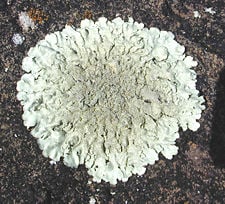
Flora
The climate of Antarctica does not allow extensive vegetation. A combination of freezing temperatures, poor soil quality, lack of moisture, and lack of sunlight inhibit the flourishing of plants. As a result, plant life is limited to mostly mosses and liverworts. The autotrophic community is made up of mostly protists. The flora of the continent largely consists of lichens, bryophytes, algae, and fungi. Growth generally occurs in the summer, and only for a few weeks at most.
There are more than 200 species of lichens and approximately 50 species of bryophytes, such as mosses. Seven hundred species of algae exist, most of which are phytoplankton. Multicolored snow algae and diatoms are especially abundant in the coastal regions during the summer. There are two species of flowering plants found in the Antarctic Peninsula: Deschampsia antarctica (Antarctic hair grass) and Colobanthus quitensis (Antarctic pearlwort).
Fauna
Land fauna is nearly completely invertebrate. Invertebrate life includes microscopic mites, lice, nematodes, tardigrades, rotifers, krill, and springtails. The flightless midge Belgica antarctica, just 12 mm in size, is the largest land animal in Antarctica. The Snow Petrel is one of only three birds that breed exclusively in Antarctica. They have been seen at the South Pole.
A variety of marine animals exist and rely, directly or indirectly, on the phytoplankton. Antarctic sea life includes penguins, blue whales, orcas, and fur seals. The Emperor penguin is the only penguin that breeds during the winter in Antarctica, while the Adélie Penguin breeds farther south than any other penguin. The Rockhopper penguin has distinctive feathers around the eyes, giving the appearance of elaborate eyelashes. King penguins, Chinstrap penguins, and Gentoo Penguins also breed in the Antarctic. It is the male partner of both the King and Emperor penguins that is responsible for incubating the single egg for up to two months by balancing it on top of their feet and keeping it warm under a special pouch, while the female feeds out at sea.
The Antarctic fur seal was very heavily hunted in the eighteenth and nineteenth centuries for its pelt by sealers from the United States and the United Kingdom. The Weddell Seal, a "true seal," is named after Sir James Weddell, commander of British sealing expeditions in the Weddell Sea. Antarctic krill, which congregates in large schools, is the keystone species of the ecosystem of the Southern Ocean, and is an important food organism for whales, seals, leopard seals, fur seals, squid, icefish, penguins, albatrosses, and many other birds.
The 1978 enactment of the Antarctic Conservation Act in the U.S. brought several restrictions to U.S. activity on the continent. The introduction of alien plants or animals can bring a criminal penalty, as can the extraction of any indigenous species. The overfishing of krill, which plays a large role in the Antarctic ecosystem, led officials to enact regulations on fishing. The Convention for the Conservation of Antarctic Marine Living Resources (CCAMLR), a treaty that came into force in 1980, requires that regulations managing all Southern Ocean fisheries consider potential effects on the entire Antarctic ecosystem. Despite these new acts, unregulated and illegal fishing, particularly of Patagonian toothfish, remains a serious problem. The illegal fishing of toothfish has been increasing, with estimates of 32,000 tons in the year 2000.
Climate
Antarctica is the coldest place on Earth. It is a frozen desert with little precipitation; the South Pole itself receives less than 4 inches (10 cm) per year, on average. Temperatures reach a minimum of between -80°C and -90°C (-112°F and -130°F) in the interior in winter and reach a maximum of between 5°C and 15°C (41°F and 59°F) near the coast in summer. Sunburn is often a health issue as the snow surface reflects almost all of the ultraviolet light falling on it.
Eastern Antarctica is colder than its western counterpart because of its higher elevation. Weather fronts rarely penetrate far into the continent, leaving the center cold and dry. Despite the lack of precipitation over the central portion of the continent, ice there lasts for extended time periods. Heavy snowfalls are not uncommon on the coastal portion of the continent, where snowfalls of up to 1.22 meters (48 inches) in 48 hours have been recorded. At the edge of the continent, strong katabatic winds off the polar plateau often blow at storm force. In the interior, however, wind speeds are typically moderate. During summer, more solar radiation reaches the surface during clear days at the South Pole than at the equator because of the 24 hours of sunlight each day at the Pole.
Antarctica is colder than the Arctic for two reasons. First, much of the continent is more than 3 km above sea level, and temperature decreases with elevation. Second, the Arctic Ocean covers the north polar zone: The ocean's relative warmth is transferred through the icepack and prevents temperatures in the Arctic regions from reaching the extremes typical of the land surface of Antarctica.
Given the latitude, long periods of constant darkness or constant sunlight create climates unfamiliar to human beings in much of the rest of the world. The aurora australis, commonly known as the southern lights, is observed in the night sky near the South Pole. Typically the aurora appears either as a diffused glow or as "curtains" that approximately extend in the east-west direction. Each curtain consists of many parallel rays, each lined up with the local direction of the magnetic field lines, suggesting that aurora is shaped by the earth's magnetic field. Another unique spectacle is diamond dust, a ground-level cloud composed of tiny ice crystals that may continue for several days without interruption. It generally forms under otherwise clear or nearly clear skies, so people sometimes also refer to it as clear-sky precipitation. A sun dog, a frequent atmospheric optical phenomenon, is a bright "spot" beside the true sun that typically appears when the sun is low, such as at sunrise and sunset.
Geology
Geological history and paleontology
More than 170 million years ago, Antarctica was part of the supercontinent Gondwana. Over time, Gondwana gradually broke apart and Antarctica as it is known today was formed around 25 million years ago.
Paleozoic era (540-250 Mya)
During the Cambrian period, Gondwana had a mild climate. West Antarctica was partially in the northern hemisphere, and during this period large amounts of sandstones, limestones, and shales were deposited. East Antarctica was at the equator, where sea-floor invertebrates and trilobites flourished in the tropical seas. By the start of the Devonian period (416 Mya), Gondwana was in more southern latitudes and the climate was cooler, though fossils of land plants are known from this time. Sand and silts were laid down in what is now the Ellsworth, Horlick, and Pensacola Mountains. Glaciation began at the end of the Devonian period (360 Mya), as Gondwana became centered around the South Pole and the climate cooled, though flora remained. During the Permian period, the plant life became dominated by fern-like plants such as Glossopteris, which grew in swamps. Over time these swamps became deposits of coal in the Transantarctic Mountains. Towards the end of the Permian period, continued warming led to a dry, hot climate over much of Gondwana.
Mesozoic era (250-65 Mya)
As a result of continued warming, the polar ice caps melted and much of Gondwana became a desert. In East Antarctica, the seed fern became established, and large amounts of sandstone and shale were laid down at this time. The Antarctic Peninsula began to form during the Jurassic period (206-146 Mya), and islands gradually rose out of the ocean. Ginkgo trees and cycads were plentiful during this period, as were reptiles such as Lystrosaurus. In West Antarctica, coniferous forests dominated through the entire Cretaceous period (146-65 Mya), though Southern beech began to take over at the end of this period. Ammonites were common in the seas around Antarctica, and dinosaurs were also present, though only two Antarctic dinosaur species (Cryolophosaurus, from the Hanson Formation, and Antarctopelta) have been described to date. It was during this period that Gondwana began to break up.
Gondwana breakup (160-23 Mya)
Africa separated from Antarctica around 160 Mya, followed by the Indian subcontinent, in the early Cretaceous (about 125 Mya). About 65 Mya, Antarctica (then connected to Australia) still had a tropical to subtropical climate, complete with a marsupial fauna. About 40 Mya Australia-New Guinea separated from Antarctica and the first ice began to appear. Around 23 Mya, the Drake Passage opened between Antarctica and South America, which resulted in the Antarctic Circumpolar Current. The ice spread, replacing the forests that then covered the continent. Since about 15 Mya, the continent has been mostly covered with ice.
Geology of present-day Antarctica
The geological study of Antarctica has been greatly hindered by the fact that nearly all of the continent is permanently covered with a thick layer of ice. However, new techniques such as remote sensing, ground-penetrating radar, and satellite imagery have begun to reveal the structures beneath the ice.
Geologically, West Antarctica closely resembles the Andes mountain range of South America. The Antarctic Peninsula was formed by uplift and metamorphism of sea-bed sediments during the late Paleozoic and the early Mesozoic eras. This sediment uplift was accompanied by igneous intrusions and volcanism. The most common rocks in West Antarctica are andesite and rhyolite volcanics formed during the Jurassic period. There is also evidence of volcanic activity, even after the ice sheet had formed, in Marie Byrd Land and Alexander Island. The only anomalous area of West Antarctica is the Ellsworth Mountains region, where the stratigraphy is more similar to the eastern part of the continent.
East Antarctica is geologically varied, dating from the Precambrian era, with some rocks formed more than 3 billion years ago. It is composed of a metamorphic and igneous platform which is the basis of the continental shield. On top of this base are various modern rocks, such as sandstones, limestones, coal, and shales laid down during the Devonian and Jurassic periods to form the Transantarctic Mountains. In coastal areas such as Shackleton Range and Victoria Land some faulting has occurred.
The main mineral resource known on the continent is coal. It was first recorded near the Beardmore Glacier by Frank Wild on the Nimrod Expedition, and now low-grade coal is known across many parts of the Transantarctic Mountains. The Prince Charles Mountains contain significant deposits of iron ore. The most valuable resources of Antarctica lie offshore, namely the oil and natural gas fields found in the Ross Sea in 1973. Exploitation of all mineral resources is banned until 2048 by the Protocol on Environmental Protection to the Antarctic Treaty.
Population
Antarctica has no permanent residents, but a number of governments maintain permanent research stations throughout the continent. The number of people conducting and supporting scientific research and other work on the continent and its nearby islands varies from approximately 4,000 in summer to about 1,000 in winter. Many of the stations are staffed year-round.
The first semi-permanent inhabitants of regions near Antarctica (areas situated south of the Antarctic Convergence) were British and American sealers who often spent a year or more on South Georgia Island, beginning in 1786. During the whaling era, which lasted until 1966, the population of that island varied from over 1,000 in the summer (over 2,000 in some years) to some 200 in the winter. Most of the whalers were Norwegian, with an increasing proportion of Britons. The settlements included Grytviken, Leith Harbour, King Edward Point, Stomness, Husvik, Prince Olav Harbour, Ocean Harbour, and Godthul. Managers and other senior officers of the whaling stations often lived together with their families. Among them was the founder of Grytviken, Captain Carl Anton Larsen, a prominent Norwegian whaler and explorer who adopted British citizenship in 1910, along with his family.
The first child born in the southern polar region was Norwegian girl Solveig Gunbjörg Jacobsen, born in Grytviken on October 8, 1913, with her birth being registered by the resident British Magistrate of South Georgia. She was a daughter of Fridthjof Jacobsen, the assistant manager of the whaling station, and of Klara Olette Jacobsen. Jacobsen arrived on the island in 1904 to become the manager of Grytviken, serving from 1914 to 1921; two of his children were born on the island.
Emilio Marcos Palma was the first person born on the Antarctic mainland, at Base Esperanza in 1978; his parents were sent there along with seven other families by the Argentinean government to determine if family life was suitable on the continent. In 1986, Juan Pablo Camacho was born at the Presidente Eduardo Frei Montalva Base, becoming the first Chilean born in Antarctica. Several bases are now home to families with children attending schools at the station.
Politics
As the only uninhabited continent, Antarctica has no government and belongs to no country. Various countries claim areas of it, although as a rule, no other countries recognize such claims. The area between 90°W and 150°W is the only part of Antarctica, indeed the only solid land on Earth, not claimed by any country.
Since 1959, claims on Antarctica have been suspended and the continent is considered politically neutral. Its status is regulated by the 1959 Antarctic Treaty and other related agreements, collectively called the Antarctic Treaty System. For the purposes of the Treaty System, Antarctica is defined as all land and ice shelves south of 60°S. The treaty was signed by twelve countries, including the Soviet Union (and later Russia), the United Kingdom, and the United States. It set aside Antarctica as a scientific preserve, established freedom of scientific investigation, environmental protection, and banned military activity on that continent. This was the first arms control agreement established during the Cold War.
The Antarctic Treaty prohibits any military activity in Antarctica, such as the establishment of military bases and fortifications, the carrying out of military maneuvers, or the testing of any type of weapon. Military personnel or equipment are permitted only for scientific research or for other peaceful purposes.[7]
The United States military issues the Antarctica Service Medal to military members or civilians who perform research duty in Antarctica. The medal includes a "wintered over" bar issued to those who remain on the continent for two complete six-month seasons.
The Antarctic Treaty
The main treaty was opened for signature on December 1, 1959, and officially entered into force on June 23, 1961. The original signatories were the 12 countries active in Antarctica during the International Geophysical Year of 1957-58 and willing to accept a U.S. invitation to the conference at which the treaty was negotiated. These countries were Argentina, Australia, Belgium, Chile, France, Japan, New Zealand, Norway, South Africa, the USSR, the United Kingdom, and the United States (which opened the Amundsen-Scott South Pole Station for the International Geophysical Year).
Articles of the Antarctic Treaty
- Article 1—area to be used for peaceful purposes only; military activity, such as weapons testing, is prohibited, but military personnel and equipment may be used for scientific research or any other peaceful purpose;
- Article 2—freedom of scientific investigation and cooperation shall continue;
- Article 3—free exchange of information and personnel in cooperation with the United Nations and other international agencies;
- Article 4—does not recognize, dispute, or establish territorial claims and no new claims shall be asserted while the treaty is in force;
- Article 5—prohibits nuclear explosions or disposal of radioactive wastes;
- Article 6—includes under the treaty all land and ice shelves south of 60 degrees 00 minutes south;
- Article 7—treaty-state observers have free access, including aerial observation, to any area and may inspect all stations, installations, and equipment; advance notice of all activities and of the introduction of military personnel must be given;
- Article 8—allows for jurisdiction over observers and scientists by their own states;
- Article 9—frequent consultative meetings take place among member nations;
- Article 10—treaty states will discourage activities by any country in Antarctica that are contrary to the treaty;
- Article 11—disputes to be settled peacefully by the parties concerned or, ultimately, by the International Court of Justice;
- Articles 12, 13, 14—deal with upholding, interpreting, and amending the treaty among involved nations.
The main objective of the ATS is to ensure in the interests of all humanity that Antarctica shall continue forever to be used exclusively for peaceful purposes and shall not become the scene or object of international discord. The treaty forbids any measures of a military nature, but not the presence of military personnel per se. It avoided addressing the question of existing territorial claims asserted by some nations and not recognized by others.
Other agreements
Other agreements, some 200 recommendations adopted at treaty consultative meetings and ratified by governments, include:
- Agreed Measures for the Conservation of Antarctic Fauna and Flora (1964) (entered into force in 1982)
- The Convention for the Conservation of Antarctic Seals (1972)
- The Convention for the Conservation of Antarctic Marine Living Resources (1980)
- The Convention on the Regulation of Antarctic Mineral Resource Activities (1988) (although it was signed in 1988, it was subsequently rejected and never entered into force)
- The Protocol on Environmental Protection to the Antarctic Treaty was signed October 4, 1991 and entered into force January 14, 1998; this agreement prevents development and provides for the protection of the Antarctic environment through five specific annexes on marine pollution, fauna, and flora, environmental impact assessments, waste management, and protected areas. It prohibits all activities relating to mineral resources except scientific.
Economy
Although coal, hydrocarbons, iron ore, platinum, copper, chromium, nickel, gold, and other minerals have been found, they have not been located in large enough quantities to exploit. The 1991 Protocol on Environmental Protection to the Antarctic Treaty also restricts a struggle for resources. In 1998, a compromise agreement was reached to add a 50-year ban on mining until the year 2048, further limiting economic development and exploitation. The primary agricultural activity is the capture and offshore trading of fish. Antarctic fisheries in 2000-01 reported landing 112,934 tons.
Small-scale tourism has existed since 1957 and is currently largely self-regulated by the International Association of Antarctica Tour Operators (IAATO). However, not all vessels associated with Antarctic tourism are members of IAATO. Several ships transport people to Antarctica to visit specific scenic locations.
There has been some recent concern over the adverse environmental and ecosystem effects caused by the influx of visitors. A call for stricter regulations for ships and a tourism quota have been made by some environmentalists and scientists. Antarctic sightseeing flights (which did not land) operated out of Australia and New Zealand until the fatal crash of Air New Zealand Flight 901 in 1979 on Mount Erebus, which killed all 257 aboard. Qantas Airlines resumed commercial overflights to Antarctica from Australia in the mid-1990s.
Transportation
Transportation on the continent has transformed from heroic explorers crossing the isolated remote area of Antarctica on foot to a more open area due to human technologies enabling more convenient and faster transport by land and predominantly air and water.
Aircraft and pilots need to be capable of landing on ice, snow, or gravel runways, as there are no paved runways. Landings are generally restricted to the daylight season (Summer months from October to March). Winter landings have been performed at Williams Field but low temperatures mean that aircraft cannot stay on the ice longer than an hour or so, as their skis may freeze to the ice runway. Travel is normally by military aircraft delivering cargo.
Major landing fields include:
- Williams Field—Serves McMurdo Station and Scott Base.
- Pegasus Blue-Ice Runway—Serves McMurdo Station and Scott Base.
- Annual Sea-Ice Runway—Serves McMurdo Station and Scott Base.
In the Antarctic summer, several companies offer excursions on ice-strengthened vessels to Antarctica. Ice-strengthened (not quite as tough as icebreaker) boats are preferred since icebreakers are round on the bottom—a configuration that amplifies the already massive wave action in the Drake passage.
Research
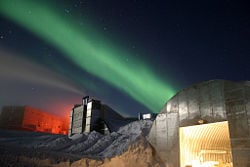
Each year, scientists from 27 different nations conduct experiments not reproducible in any other place in the world. In the summer more than 4,000 scientists operate research stations; this number decreases to nearly 1,000 in the winter. McMurdo Station is capable of housing more than 1,000 scientists, visitors, and tourists.
Researchers include biologists, geologists, oceanographers, physicists, astronomers, glaciologists, and meteorologists. Geologists tend to study plate tectonics, meteorites from space, and resources from the breakup of the super continent Gondwanaland. Glaciologists in Antarctica are concerned with the study of the history and dynamics of floating ice, seasonal snow, glaciers, and ice sheets. Biologists, in addition to examining the wildlife, are interested in how harsh temperatures and the presence of people affect adaptation and survival strategies in a wide variety of organisms. Medical physicians have made discoveries concerning the spreading of viruses and the body's response to extreme seasonal temperatures. Astrophysicists at Amundsen-Scott South Pole Station study the celestial dome and cosmic microwave background radiation.
Many astronomical observations are better made from the interior of Antarctica than from most surface locations because of the high elevation, which results in a thin atmosphere and low temperature, which minimizes the amount of water vapor in the atmosphere, thus allowing for a view of space clearer than anywhere else on Earth. Antarctic ice serves as both the shield and the detection medium for the largest neutrino telescope in the world, built 2 km below Amundsen-Scott station.[8]
Since the 1970s, an important focus of study has been the ozone layer in the atmosphere above Antarctica. In 1985, three British Scientists working on data they had gathered at Halley Station on the Brunt Ice Shelf discovered the existence of a hole in this layer. In 1998, NASA satellite data showed that the Antarctic ozone hole was the largest on record, covering 27 million square kilometers. It was eventually determined that the destruction of the ozone was caused by chlorofluorocarbons emitted by human products. With the ban of CFCs in the Montreal Protocol of 1989, it is believed that the ozone hole will close up over the next fifty years.
Meteorites
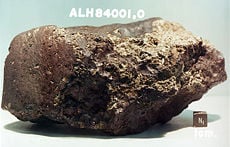
Meteorites from Antarctica are an important area of study about material formed early in the solar system; most are thought to come from asteroids, but some may have originated on larger planets. The first Antarctic meteorites were found in 1912. In 1969, a Japanese expedition discovered nine meteorites. Most of these meteorites have fallen onto the ice sheet in the last million years. Motion of the ice sheet tends to concentrate the meteorites at blocking locations such as mountain ranges, with wind erosion bringing them to the surface after centuries beneath accumulated snowfall. Compared with meteorites collected in more temperate regions on Earth, the Antarctic meteorites are well-preserved.[9]
This large collection of meteorites allows a better understanding of the abundance of meteorite types in the solar system and how meteorites relate to asteroids and comets. New types of meteorites and rare meteorites have been found. Among these are pieces blasted off the moon, and probably Mars, by impacts. These specimens, particularly ALH84001 discovered by ANSMET, are at the center of the controversy about possible evidence of microbial life on Mars. Because meteorites in space absorb and record cosmic radiation, the time elapsed since the meteorite hit the Earth can be determined from laboratory studies. The elapsed time since fall, or terrestrial residence age, of a meteorite represents more information that might be useful in environmental studies of Antarctic ice sheets.
In 2006, a team of researchers from Ohio State University used gravity measurements by NASA's Gravity Recovery and Climate Experiment (GRACE) satellites to discover the 300-mile-wide Wilkes Land crater, which probably formed about 250 million years ago.[10]
Notes
- ↑ National Geophysical Data Center, NOAA Satellite and Information Services. Retrieved July 20, 2017.
- ↑ The Mariner's Museum, Age of Exploration. Retrieved July 20, 2017.
- ↑ SouthPole.com, James Clark Ross. Retrieved July 20, 2017.
- ↑ Australian Antarctic Division, Tannatt William Edgeworth David. Retrieved July 20, 2017.
- ↑ SouthPole.com, Roald Amundsen. Retrieved July 20, 2017.
- ↑ National Science Foundation, Scientists Discover Undersea Volcano Off Antarctica. Retrieved July 20, 2017.
- ↑ Scientific Committee on Antarctic Research, The Antarctic Treaty System: An Introduction. Retrieved July 20, 2017.
- ↑ World's Largest Neutrino Observatory Built at South Pole Live Science, December 20, 2010. Retrieved July 20, 2017.
- ↑ NASA Astromaterials Curation, Meteorites from Antarctica. Retrieved July 20, 2017.
- ↑ Robert Roy Britt, Giant Crater Found: Tied to Worst Mass Extinction Ever Space.com, June 1, 2006. Retrieved July 20, 2017.
ReferencesISBN links support NWE through referral fees
- Bledsoe, Lucy Jane. How to survive in Antarctica. New York: Holiday House, 2006. ISBN 0823418901
- Ley, Willy. The Poles. Life nature library. New York: Time, Inc., 1962. ASIN B0006AXV8M
- Petersen, David. Antarctica. A true book. New York: Children's Press, 1998. ISBN 0516207709
- Robinson, Kim Stanley. Antarctica. New York: Bantam Books, 1998. ISBN 0553100637
- United States. Antarctic region. Washington, DC: Central Intelligence Agency, 2002. OCLC 51484802
External links
All links retrieved July 31, 2023.
- Antarctica CIA World Factbook
- Discovering Antarctica.
- Antarctica Pictures, Information and Travel Cool Antarctica.
Credits
New World Encyclopedia writers and editors rewrote and completed the Wikipedia article in accordance with New World Encyclopedia standards. This article abides by terms of the Creative Commons CC-by-sa 3.0 License (CC-by-sa), which may be used and disseminated with proper attribution. Credit is due under the terms of this license that can reference both the New World Encyclopedia contributors and the selfless volunteer contributors of the Wikimedia Foundation. To cite this article click here for a list of acceptable citing formats.The history of earlier contributions by wikipedians is accessible to researchers here:
The history of this article since it was imported to New World Encyclopedia:
Note: Some restrictions may apply to use of individual images which are separately licensed.
